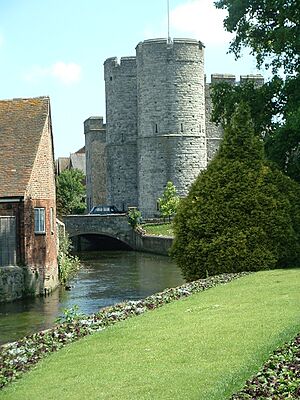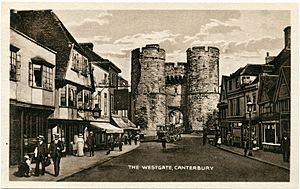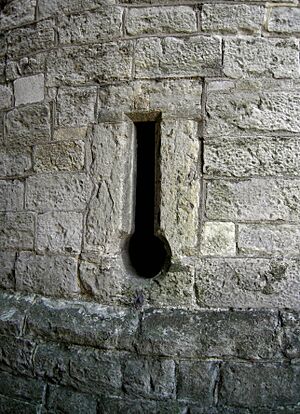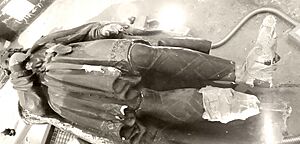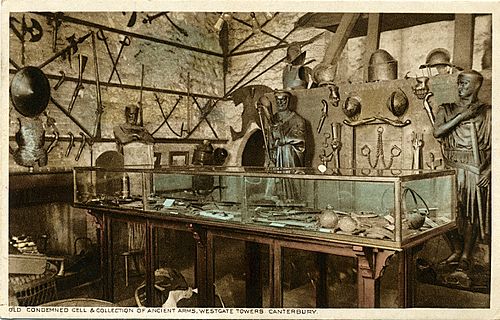Westgate, Canterbury facts for kids
Quick facts for kids Westgate |
|
|---|---|
| West Gate Towers Museum | |
| Part of Canterbury city wall | |
| St Peter's Street, Canterbury, Kent CT1 2BQ | |
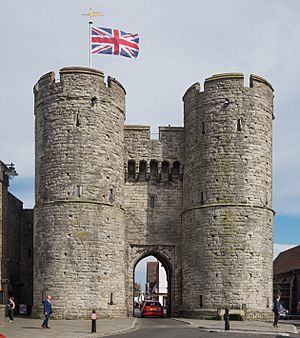
Westgate
|
|
| Type | Gatehouse |
| Height | 60 feet (18 m) |
| Site information | |
| Owner | Canterbury City Council |
| Condition | Well-preserved |
| Site history | |
| Built | 1380 |
| Built by | Archbishop Simon Sudbury |
| In use | 1380−present |
| Materials | Kentish ragstone |
The Westgate is a huge medieval gatehouse in Canterbury, Kent, England. This amazing 60-foot (18 m) tall gate is the biggest city gate still standing in England! It was built around 1379 using strong Kentish ragstone.
The Westgate is the last of Canterbury's seven medieval gates. It is still in great shape and is one of the city's most famous sights. Even today, cars drive right through its big round towers. This special building is now home to the West Gate Towers Museum and some fun escape rooms.
Contents
Westgate's Long History
From Roman Times to Medieval Rebuilds
The ancient Romans first built walls around Canterbury about 300 AD. The Westgate has always been the most important gate. This is because it was the main entrance from London and most of Kent.
The gate you see today replaced an older Roman gate. It was rebuilt around 1380. There was a gate here even during the Norman conquest. For a long time, a church called Holy Cross sat on top of the gate. But both the church and the old gate were taken down in 1379.
Archbishop Simon Sudbury rebuilt the gate before he died in 1381. Some people think it was built for pilgrims visiting St Thomas Becket at the cathedral. But it was also built to look strong and defend against possible attacks from the French. Archbishop Sudbury and taxes helped pay for this big project.
Westgate as a Prison and Beyond
In 1453, the city leaders were allowed to use Westgate as a jail. So, from the 15th to the 19th century, the building was Canterbury's prison. The guard rooms, which had lots of wood in the 18th century, became cells for prisoners. The room above the arch became the cell for those waiting for serious punishment.
Before 1775, there was a special cage in the prison gateway. Some prisoners could sit there and ask people passing by for help. In January 1648, after a riot, Parliamentarians burned all the wooden doors of the city gates. New doors were put in around 1660, but these were removed later.
The Westgate in Modern Times
In the 1800s, parts of the city walls connected to the gate were removed. From 1823 to 1829, a jailer's house was built next to the gate. This building later became the main office for the Canterbury City Police. Today, it is a bar and cafe.
A disused iron bridge connects the Westgate to this bar and cafe. This bridge was built around the same time. To handle more traffic, new roads and passages were also built around the Westgate and across the River Stour.
Towards the end of the 19th century, the Westgate stored the city's old records. Then, in 1906, a museum opened inside the gatehouse.
In 2009–2010, the Canterbury City Council thought about closing the museum. This idea caused a lot of discussion. The museum, now called the Westgate Towers Museum, reopened in 2011. After some challenges, the Westgate finally reopened to the public on August 3, 2015.
Today, the Westgate is still the largest city gate in England. It is a protected building because of its history.
Westgate's Amazing Architecture
The Westgate is built with beautiful, carefully cut coursed ashlar ragstone. It has strong bases for its round towers, battlements (walls with gaps for defense), and machicolations (openings to drop things on attackers). It also has eighteen gunloops, which are holes for guns. This was a very high number for a gate and among the earliest gunholes in Britain! These gunloops were likely added by the early 1400s.
The gate also had a drawbridge over the River Stour, a heavy metal portcullis that could be lowered, and strong wooden doors.
Inside the Gatehouse
The gateway has three floors.
- The ground floor has the main passage for people and carts. It also has entrances to rooms inside each tower. Each tower room on this floor had a fireplace and four gunloops. The north tower had a spiral staircase leading to the upper floors.
- The first floor has a large room with a fireplace. This room originally held the machinery for the portcullis. It also had doors to the upper rooms of each tower, which also had fireplaces and three gunloops. A northern door led to a spiral staircase going up to the roof. In the 1490s, a large window was added to this main room. It offered a view towards the cathedral and along St Peter's Street.
- The roof over the central room has a battlemented walkway. From here, you could reach the tops of both towers and the machicolations. There were also two small rooms in the tops of the towers, each with two gunports. Later, between 1793 and 1794, the main hall over the gate was divided into three. A square lantern was added to the roof, along with the wooden doors and cell linings you can see today.
Museum Exhibits: Magna Carta Models
The museum displays some very special items: 17 large, six-foot-tall, painted plaster models called maquettes. These models were made between 1847 and 1851. They were created as practice pieces for the 16 bronze statues of barons and two bishops that stand in the Lords Chamber at Westminster Palace in London.
These maquettes represent the important men who signed the Magna Carta, a famous document from 1215 that limited the power of the king. Each of the fifteen barons and two bishops is named at the base of their model.
In 1908, three of these maquettes were shown in the museum. In 2013, two were still on display. The rest were stored in the ground floor room of the north tower in 1987. They were forgotten until museum staff rediscovered them in May 2008, after the building flooded. Most of them are still there.
Some of the sculptors who made these maquettes include John Thomas, Patrick MacDowell, and Frederick Thrupp. As of 2021, three of the maquettes (Stephen Langton, Thomas Robert Fitzwalter, and Sieur de Quincy) have been restored. They are now displayed at The Beaney museum in Canterbury.
-
Civil War armour
-
A 19th-century model of Knight Templar St Maur, who signed Magna Carta.
-
Stephen Langton by John Thomas.
See also
- A Canterbury Tale
- Herne Bay Museum
- Roman Museum
- Westgate Hall, Canterbury
- Whitstable Museum and Gallery


